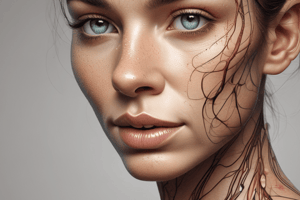Podcast
Questions and Answers
What is the primary function of fibroblasts in response to injury?
What is the primary function of fibroblasts in response to injury?
- To regenerate sweat glands
- To remove dead skin cells
- To proliferate and manufacture new collagen (correct)
- To produce melanin
What is the role of epidermal appendages in recovery from superficial scrapes and burns?
What is the role of epidermal appendages in recovery from superficial scrapes and burns?
- To regenerate the epidermis (correct)
- To absorb nutrients from the dermis
- To produce collagen
- To produce melanin
What is the main component of the epidermis?
What is the main component of the epidermis?
- Langerhans cells
- Keratinocytes (correct)
- Fibroblasts
- Melanocytes
What is responsible for the yellow/brown color of the epidermis?
What is responsible for the yellow/brown color of the epidermis?
What is responsible for the pinkness of unpigmented skin?
What is responsible for the pinkness of unpigmented skin?
Flashcards are hidden until you start studying
Study Notes
Skin Functions
- Provides a physical barrier against thermal and mechanical insults, pathogens, and excessive water loss or uptake
- Protects cell nuclei from UV radiation through melanin in the epidermis
- Allows selective permeability for lipophilic drugs and hormones through skin patches
- Monitors the environment through sensory receptors and mechanoreceptors
- Synthesizes vitamin D3 through UV light for calcium metabolism and bone formation
Thermoregulation
- Controls heat transfer across the body's surface, facilitating heat retention and dissipation
- Sweat glands are vital for thermoregulation, and evaporating sweat can cool skin below core temperature
- Normal thermoregulatory sweating is often insensible, with sweat evaporating quickly
Additional Functions
- Releases visual and pheromonal signals, such as blushing and body odor
- Plays a crucial role in wound healing, with cells responding quickly to damage and regeneration
- Epithelial replacement can spread from deep hair follicles and sweat glands if the surface epidermis is damaged
Epidermis
- Consists primarily of keratinocytes with intercellular junctions (desmosomes) and intercellular channels for nutrient diffusion
- Keratinocytes are characterized by numerous desmosomes, visible as fine "prickles" between adjacent cells
Skin Color
- Skin is moderately transparent, with light penetrating and being reflected back from epidermal cells, collagen, and blood
- Melanin contributes a yellow/brown color to the epidermis, while collagen scatters light without altering its color
- Hemoglobin in red blood cells scatters red light, responsible for the pinkness of unpigmented skin
Studying That Suits You
Use AI to generate personalized quizzes and flashcards to suit your learning preferences.




